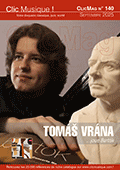 Sebastian de Albero fut une comète de l'histoire de la musique. Claveciniste à la chapelle royale de Madrid sous Fernando VI où il fréquenta Domenico Scarlatti et José de Nebra. il trouva la mort à l'âge de trente trois ans. Son œuvre se résume à trente sonates pour clavier plus quelques travaux et exercices de composition et sa discographie est famélique. Le style d'Albero (sautillements, formules rythmiques répétées à l'envie) fait penser de façon évidente à Scarlatti et la versatilité à Carl Philip Emmanuel Bach. Laure Colladant avait déjà gravé l'intégrale des sonates (Mandala 1995) sur un pianoforte. Si la musique d'Albero gagnait en dynamique et en profondeur, elle perdait aussi en articulation, calfeutrée dans la mécanique de l'instrument. Sur un clavecin portugais bien plus idiomatique, Alejandro Casals dévide l'écheveau contrapuntique de ces « essercisi » dans l'ordre suivant : recercata, fugue et sonate. Les longues « fugues » (certaines dépassent les dix minutes) reprennent le ou les thèmes de façon récurrente en brodant autour sans pour autant développer comme le ferait les Bach (père et fils). Le claveciniste espagnol fait bien ressortir cette manière tourmentée, obsessionnelle voire mélancolique du compositeur. (Jérôme Angouillant)  If the name of Sebastian de Albero (or to give him his full title, Sebastián Ramón de Albero Añanos) is encountered at all in the record catalogues, it is for the 30 brief keyboard sonatas, which are stylish and exuberant works in the early 18th-century Spanish style perfected by Domenico Scarlatti, with whom de Albero was likely acquainted while in post as the main organist at the Royal Chapel in Madrid, to which he had been appointed in 1746 at just 24 years of age. He died just ten years later, leaving to posterity only those sonatas and this more individual collection of tripartite works combining the forms of recercar, fugue and sonata. These have received much less attention on disc, making this complete recording by the Spanish harpsichordist Alejandro Casal all the more welcome. In his own detailed booklet note, Casal homes in on the collection’s most extraordinary feature, which is the length of the fugues, up to 522 bars for the A major fugue (almost ten minutes in performance; in terms of duration, three others are even longer, up to thirteen minutes); compare this to Bach’s longest keyboard fugue, of 231 bars. It would be wild overstatement to compare de Albero with Bach in terms of contrapuntal mastery, and Grove notes the tendency of the fugues in this collection towards the ‘excessive sequences’ which sustain their length, but they are ‘fetching’ nonetheless, and preceded by highly imaginative recercars written in an improvisatory, often fantastical style, without barlines, freely crossing tonal boundaries whither de Albero’s invention takes him, and demanding considerable technical élan from the performer. Indeed the concluding sonatas, while written in a rousing major-key to give the sense of an ending, could even be said to prefigure the bold Empfindsamkeit language of CPE Bach, but with a Spanish accent. The harpsichord used in this recording is a copy of an original by Joachim José Antunes, Lisboa, kept at the Finchcocks Collection in Goudhurst, and built by Ugo Casiglia (Cinisi, Italy) in 2011: it is considered among the finest examples of Iberian keyboard-construction, with a powerful, rich and melodic sound.
 |
